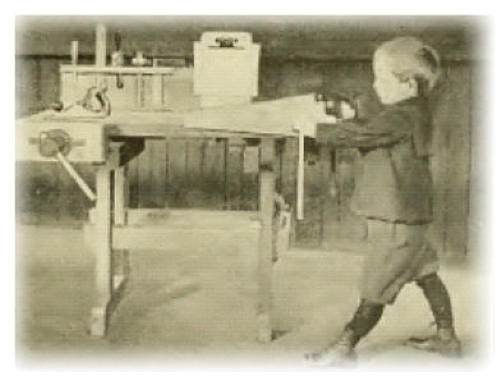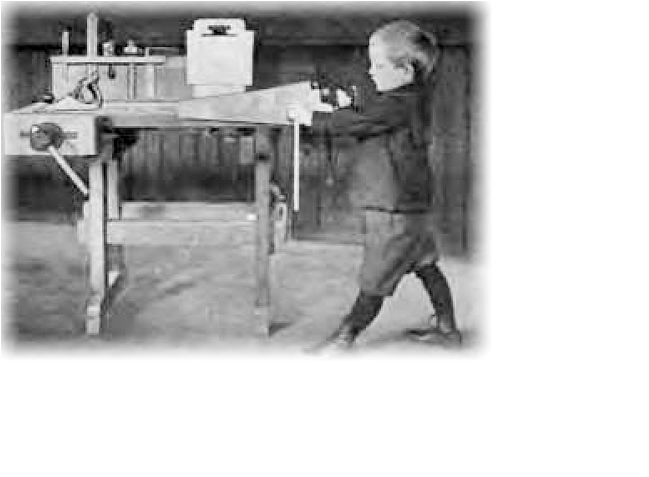
Updated - 22 October 2018
Copyright - G P Sagar 2015

Historical
"How may I recognise a good craftsman? First by the reputation of his ancestors for honesty and
sincerity: then by his ability to create something new with an experience that is old."
Confucius

It
has
been
a
long
haul
over
many
years,
running
into
centuries,
to
establish
the
value
of
practical
pursuits
within
the
school
curriculum.
Thanks
to
Plato
the
scene
was
set
regarding
the
structure
of
our
society
which
has
continued
to
this
day
fuelled
largely
by
our
universities.
Those
who
work
with
their
hands
have
for
centuries
been
regarded
as
inferior
to
those
with
an
academic
persuasion.
If
proof
of
this
is
required,
you
only
have
to
look
at
the
divisions
in
pay
and
salaries,
the examinations structure, and people's aspirations for their children.
It
has
been
long
been
recognised
that
children
have
practical
abilities
which,
given
the
opportunity,
could
be
developed
into
lifetime
pursuits.
In
fact,
if
you
consider
natural
human
development
these
aspects
are
inherent
and
only
need
harnessing or directing.
The
constant
drive
for
academic
excellence
succeeded
in
driving
skill-based
activities
into
the
background.
Of
course
it
is
essential
to
encourage
such
excellence
but
not
at
the
expense
of
other
vital
attributes.
We
are
now
reaping
the
rewards
of
this
policy,
and
sadly
reversing
the
damage
is
extremely
difficult.
The
division
between
academic
and
skill-based
is
still
as wide as ever with little chance of the academic fraternity understanding the intricacies of the problem.

Historical Notes
the teaching of craft began in a Quaker school doing the mid-1800
earlier this century teachers were supported by a professional association called the Institute of craft teachers.Universities
and higher education did not recognise the subject nor the teachers.
Up until quite recently in one school. The craft teachers were not allowed into the staffroom.
This in equality has remained until relatively recently, especially where graduates pay was on as higher scale.
Constant attempts to gain some recognition throughout all these decades have been made by the teachers professional
association. Firstly, that already mentioned, which is changed into the Institute of craft education, which then changed into
the educational Institute of design craft and technology -space all of which were run on a voluntary basis by teachers
themselves.

Sloyd is a Dirty Word !
Slojd is Tool-work so arranged and employed as to stimulate and promote Vigorous Intelligent Self-activity for a Purpose
which the worker recognizes as Good.
B. THE METHOD AND MEANS OF INSTRUCTION.
I. General principles.
Attendance at Slojd instruction should be voluntary on the part of the pupils. In order to insure this the work must fulfill the
following conditions :
1. It must be useful.
2. It must not require fatiguing preparatory exercises in the use of the various tools.
3. It must afford variety.
4. It must be capable of being carried out by the pupils themselves.
5. It must be real work, not play.
6. It must not be so called knick-knacks, that is, articles of luxury.
7. It must become the property of the pupil.
8. It must correspond with the capabilities of the pupils.
A. AIM OF THE INSTRUCTION.
Whilst the elementary schools prepare the children indirectly for life, the chief aim of the teaching of Slojd is to give the pupils
formal instruction, that is, to develop their mental and physical powers. It has also for its material and practical aim the
acquisition of general dexterity of hand.
This formal education which Slojd has in view aims principally at instilling a taste for and love of work in general ; inspiring
respect for rough, honest bodily labour; training in habits of order, exactness, cleanliness and neatness ; accustoming to
attention, industry and perseverance; promoting the development of the physical powers; training the eye and sense of for



- Personal Work Index Page
- Sophie's Egg
- The Marlin Trophy
- Rose Bowl
- Silver Cup
- Music Stand
- The Gilchrist Bowl
- Silver Golfing Marker
- Walking Stick Handles
- Turnery Work
- Other Silver Work
- Platinum Ear Drops
- General Woodwork
- The Pararule
- Oliver's Money Box
- Rings and Ring Making
- Bracelets
- Necklaces & Pendants
- Box Making
- Oak Kitchen
- Jonas Feilding Presentation
- Building / Renovation Project
- Communion Set Repair


- History of Craft Education
- Preface
- Introduction
- Setting the Scene
- Towards Design and Technology
- Historical Aspects
- The Plato Gap
- Kill the Skill
- The Colleges and Teacher Training
- The Professional Association
- The Quaker Influence
- Where Are We Now
- Personal Reflections
- Acknowledgements and Resources
- Notes
- Timeline




